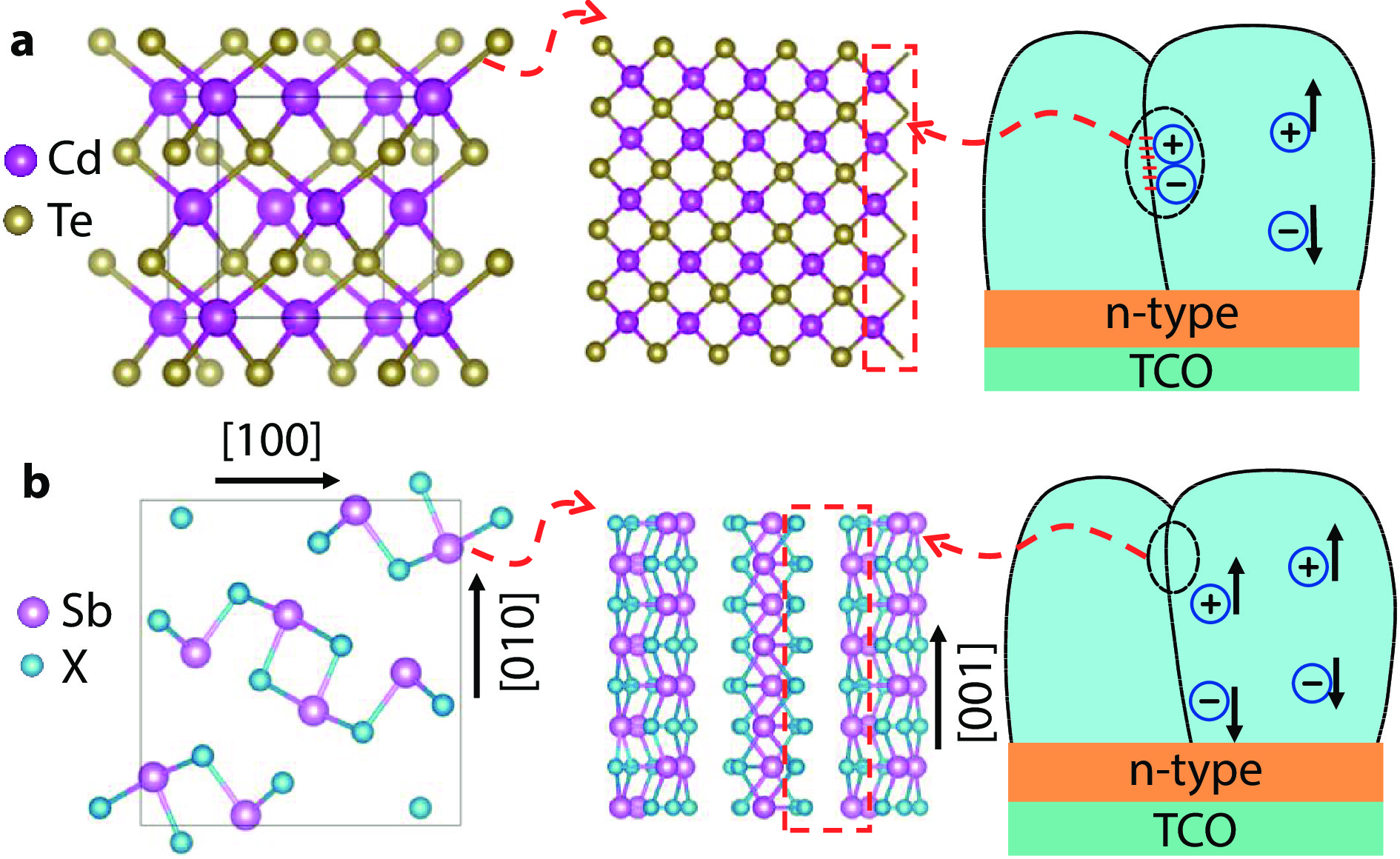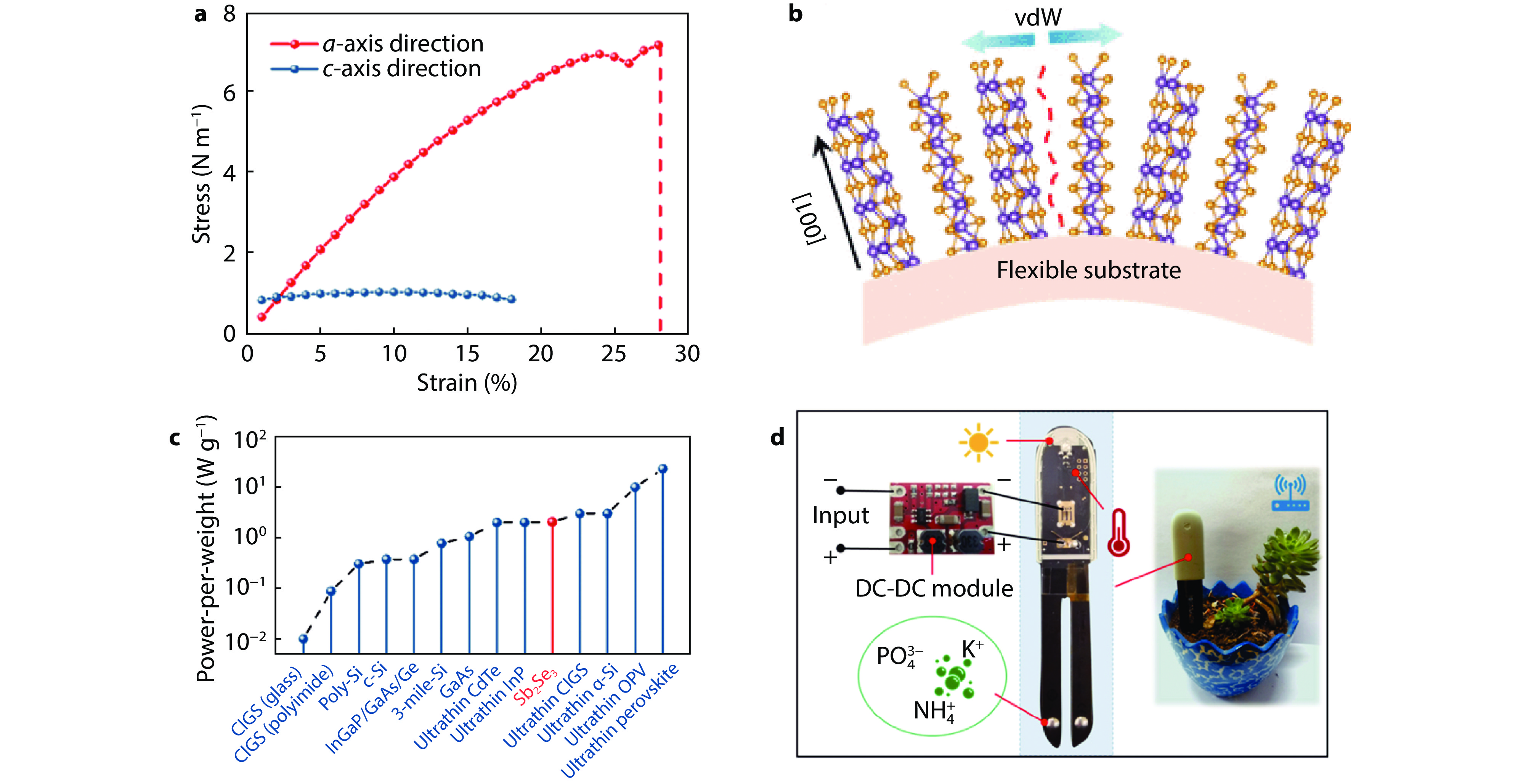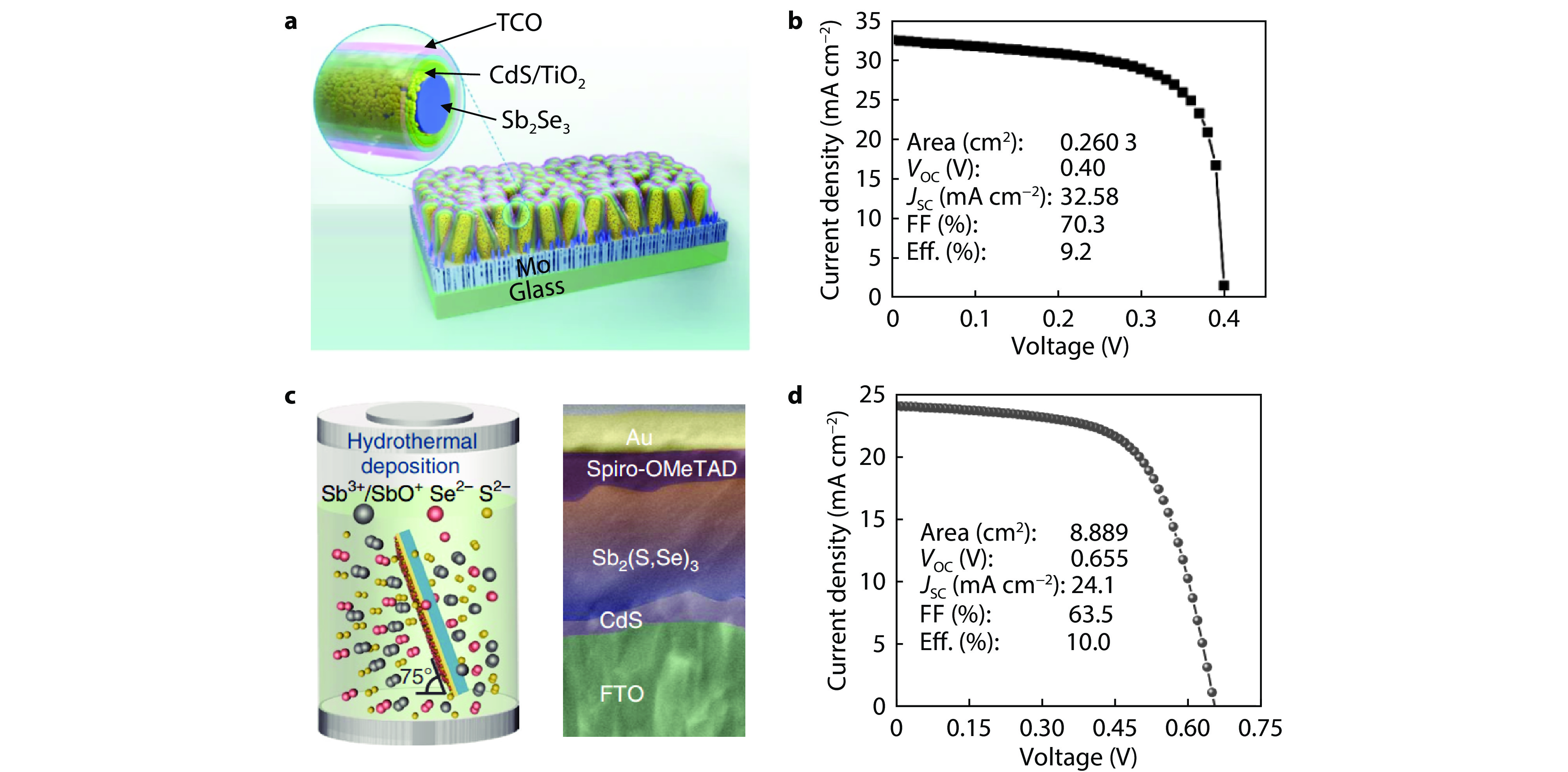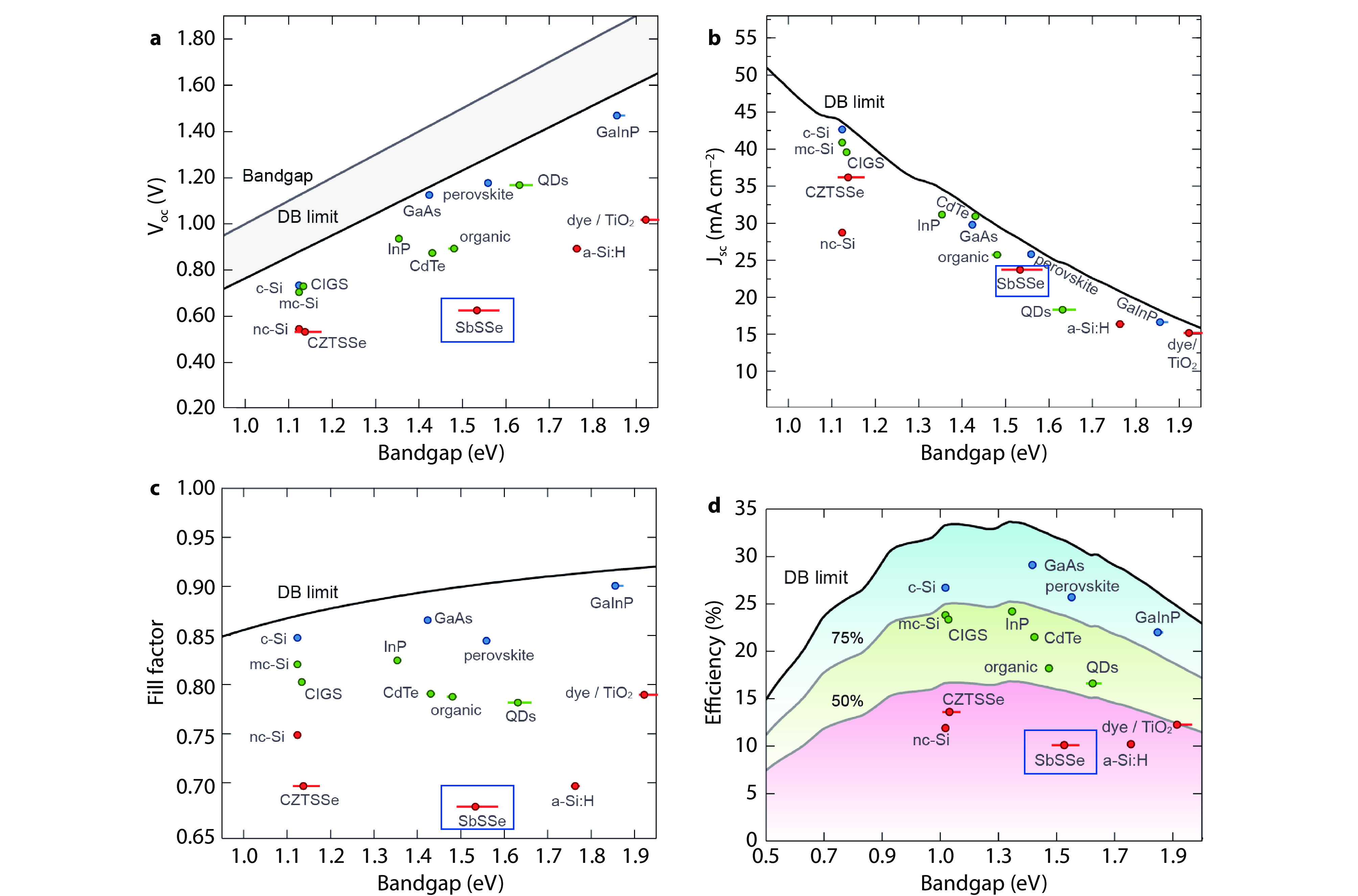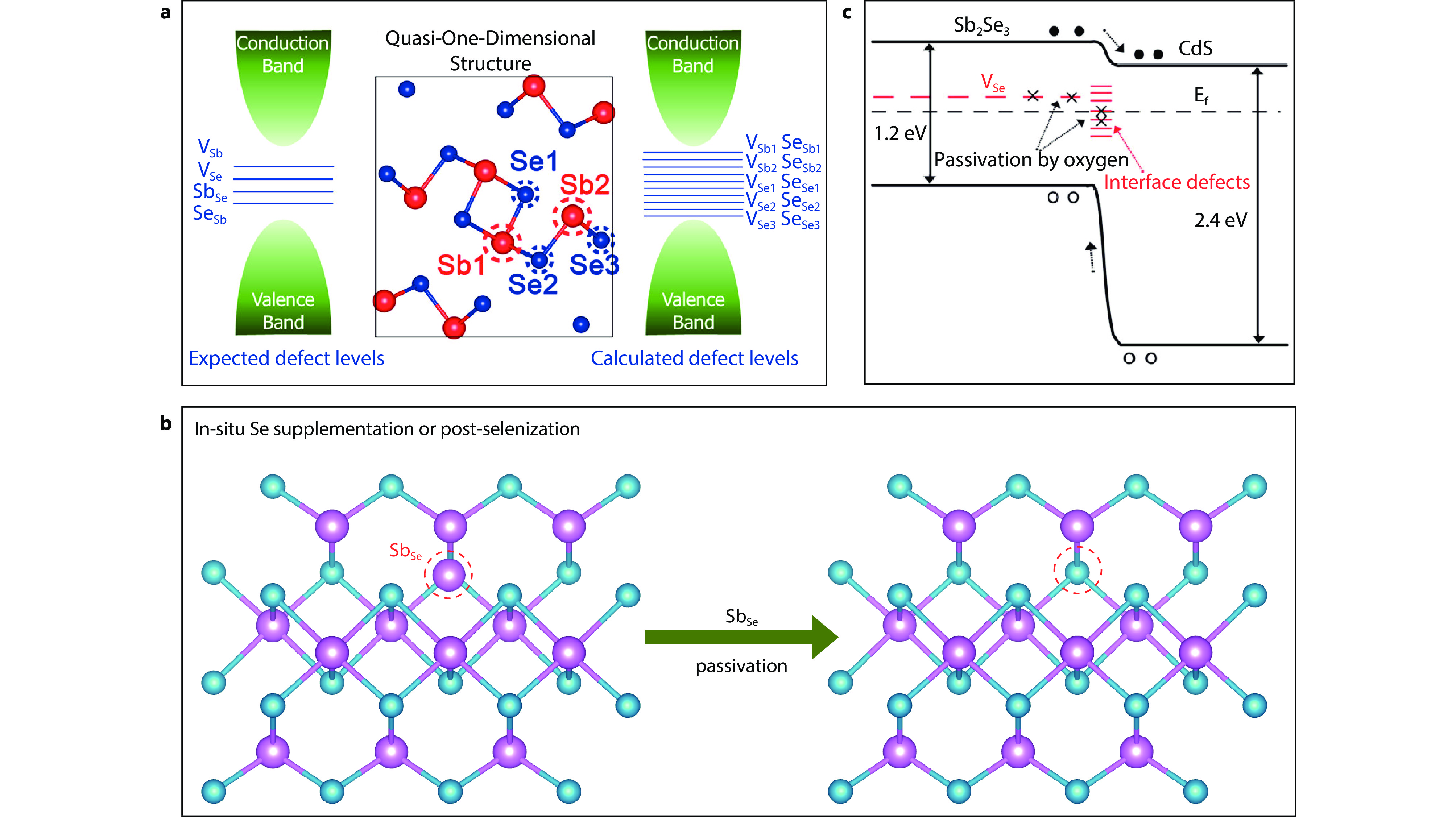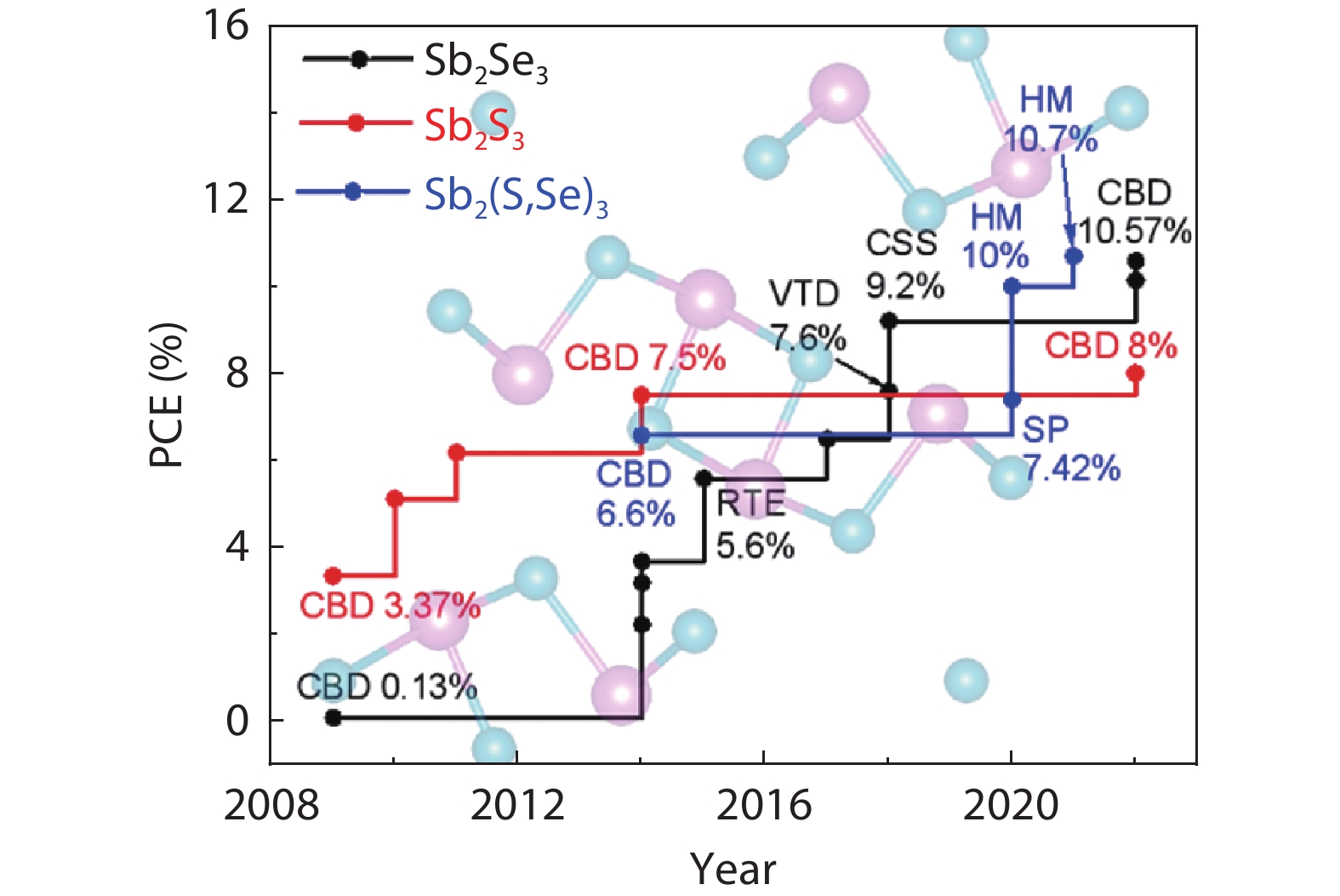| Citation: | Lijian Zhang, Chunyan Wu, Wenhao Liang, Tao Chen. Low-dimensional antimony selenosulfide as an emerging material for solar cell applications[J]. Energy Lab, 2024, 2(1): 220016. doi: 10.54227/elab.20220016 |
Low-dimensional antimony selenosulfide as an emerging material for solar cell applications
-
Abstract
Antimony chalcogenides (Sb2X3), including Sb2S3, Sb2Se3, and the alloy-type Sb2(S,Se)3, have been considered as a promising absorber materials for photovoltaic applications. Owing to its unique quasi-one-dimensional crystal structure, it displays distinct defect and carrier transport properties and requires special material synthesis strategy compared with the traditional three-dimensional crystal structure semiconductor materials. Recent studies on this class of materials have generated new understandings in film fabrication, defect characteristics and passivation, interfacial engineering, and efficiency improvement. With these efforts, the power conversion efficiency of the solar cell device has been increased from below 3% to 10.7% over the past 10 years. This efficiency achievement suggests that Sb2X3 possesses great potential for practical applications with further efficiency enhancement. This perspective article presents the critical development in the Sb2X3 materials and solar cells in recent years, including the unique crystal structure for solar cells, the preparation method for obtaining high-quality Sb2X3 films, and the discovery and passivation of unusual and complex defects. Finally, we propose several strategies for future efficiency improvement.
-

-
References
1. C. Chen, J. Tang, ACS Energy Lett., 2020, 5, 2294 2. M. A. Green, E. D. Dunlop, J. Hohl-Ebinger, M. Yoshita, N. Kopidakis, X. Hao, Prog. Photovolt: Res. Appl., 2021, 29, 657 3. NREL, Best Research-Cell Efficiency Chart, https://www.nrel.gov/pv/cell-efficiency.html, July 2023. 4. L. Zhang, S. Cheng, J. Wang, T. Chen, Sol. RRL, 2022, 6, 2200561 5. X. Jin, Y. Fang, T. Salim, M. Feng, S. Hadke, S. W. Leow, T. C. Sum, L. H. Wong, Adv. Funct. Mater., 2020, 30, 2002887 6. Y. C. Choi, D. U. Lee, J. H. Noh, E. K. Kim, S. I. Seok, Adv. Funct. Mater., 2014, 24, 3587 7. Y. Zhou, L. Wang, S. Chen, S. Qin, X. Liu, J. Chen, D.-J. Xue, M. Luo, Y. Cao, Y. Cheng, E. H. Sargent, J. Tang, Nat. Photonics, 2015, 9, 409 8. R. Tang, X. Wang, W. Lian, J. Huang, Q. Wei, M. Huang, Y. Yin, C. Jiang, S. Yang, G. Xing, S. Chen, C. Zhu, X. Hao, M. A. Green, T. Chen, Nat. Energy, 2020, 5, 587 9. X. Wang, R. Tang, C. Wu, C. Zhu, T. Chen, Journal of Energy Chemistry, 2018, 27, 713 10. H. Dong, L. Zhang, B. Che, P. Xiao, H. Wang, C. Zhu, T. Chen, ACS Appl. Opt. Mater., 2023, 1, 374 11. Y. Zhao, S. Wang, C. Jiang, C. Li, P. Xiao, R. Tang, J. Gong, G. Chen, T. Chen, J. Li, X. Xiao, Adv. Energy Mater., 2022, 12, 2103015 12. A. Mavlonov, T. Razykov, F. Raziq, J. Gan, J. Chantana, Y. Kawano, T. Nishimura, H. Wei, A. Zakutayev, T. Minemoto, X. Zu, S. Li, L. Qiao, Solar Energy, 2020, 201, 227 13. U. A. Shah, S. Chen, G. M. G. Khalaf, Z. Jin, H. Song, Adv. Funct. Mater., 2021, 31, 2100265 14. J. Dong, Y. Liu, Z. Wang, Y. Zhang, Nano Select, 2021, 2, 1818 15. C. Chen, K. Li, J. Tang, Sol. RRL, 2022, 6, 2200094 16. S. Wang, Y. Zhao, B. Che, C. Li, X. Chen, R. Tang, J. Gong, X. Wang, G. Chen, T. Chen, J. Li, X. Xiao, Adv. Mater., 2022, 34, 2206242 17. Y. Zhao, S. Wang, C. Li, B. Che, X. Chen, H. Chen, R. Tang, X. Wang, G. Chen, T. Wang, J. Gong, T. Chen, X. Xiao, J. Li, Energy Environ. Sci., 2022, 15, 5118 18. A. Polman, M. Knight, E. C. Garnett, B. Ehrler, W. C. Sinke, Science, 2016, 352, aad4424 19. L. Wang, D.-B. Li, K. Li, C. Chen, H.-X. Deng, L. Gao, Y. Zhao, F. Jiang, L. Li, F. Huang, Y. He, H. Song, G. Niu, J. Tang, Nat. Energy, 2017, 2, 17046 20. C. Chen, D. C. Bobela, Y. Yang, S. Lu, K. Zeng, C. Ge, B. Yang, L. Gao, Y. Zhao, M. C. Beard, J. Tang, Frontiers of Optoelectronics, 2017, 10, 18 21. X. Jin, Y. Fang, T. Salim, M. Feng, Z. Yuan, S. Hadke, T. C. Sum, L. H. Wong, Adv. Mater., 2021, 33, 2104346 22. K. Li, F. Li, C. Chen, P. Jiang, S. Lu, S. Wang, Y. Lu, G. Tu, J. Guo, L. Shui, Z. Liu, B. Song, J. Tang, Nano Energy, 2021, 86, 106101 23. C. Chen, K. Li, F. Li, B. Wu, P. Jiang, H. Wu, S. Lu, G. Tu, Z. Liu, J. Tang, ACS Photonics, 2020, 7, 352 24. X. Wen, Z. Lu, L. Valdman, G. C. Wang, M. Washington, T. M. Lu, ACS Appl Mater Interfaces, 2020, 12, 35222 25. C. Wang, S. Lu, S. Li, S. Wang, X. Lin, J. Zhang, R. Kondrotas, K. Li, C. Chen, J. Tang, Nano Energy, 2020, 71, 104577 26. X. Wen, Z. Lu, G.-C. Wang, M. A. Washington, T.-M. Lu, Nano Energy, 2021, 85, 106019 27. C. Wu, W. Lian, L. Zhang, H. Ding, C. Jiang, Y. Ma, W. Han, Y. Li, J. Zhu, T. Chen, C. Zhu, Sol. RRL, 2020, 4, 1900582 28. C. Wu, L. Zhang, H. Ding, H. Ju, X. Jin, X. Wang, C. Zhu, T. Chen, Sol. Energy Mater. Sol. Cells, 2018, 183, 52 29. D.-B. Li, X. Yin, C. R. Grice, L. Guan, Z. Song, C. Wang, C. Chen, K. Li, A. J. Cimaroli, R. A. Awni, D. Zhao, H. Song, W. Tang, Y. Yan, J. Tang, Nano Energy, 2018, 49, 346 30. Y. Itzhaik, O. Niitsoo, M. Page, G. Hodes, J. Phys. Chem. C, 2009, 113, 4254 31. M. Ishaq, H. Deng, U. Farooq, H. Zhang, X. Yang, U. A. Shah, H. Song, Sol. RRL, 2019, 3, 1900305 32. W. Lian, C. Jiang, Y. Yin, R. Tang, G. Li, L. Zhang, B. Che, T. Chen, Nat. Commun., 2021, 12, 3260 33. S. Messina, M. Nair, P. Nair, J. Electrochem. Soc., 2009, 156, H327 34. X. Liu, C. Chen, L. Wang, J. Zhong, M. Luo, J. Chen, D.-J. Xue, D. Li, Y. Zhou, J. Tang, Prog. Photovolt: Res. Appl., 2015, 23, 1828 35. X. Wen, C. Chen, S. Lu, K. Li, R. Kondrotas, Y. Zhao, W. Chen, L. Gao, C. Wang, J. Zhang, G. Niu, J. Tang, Nat. Commun., 2018, 9, 2179 36. C. Chen, K. Li, S. Chen, L. Wang, S. Lu, Y. Liu, D. Li, H. Song, J. Tang, ACS Energy Lett., 2018, 3, 2335 37. R. Tang, Z.-H. Zheng, Z.-H. Su, X.-J. Li, Y.-D. Wei, X.-H. Zhang, Y.-Q. Fu, J.-T. Luo, P. Fan, G.-X. Liang, Nano Energy, 2019, 64, 103929 38. Z. Li, X. Liang, G. Li, H. Liu, H. Zhang, J. Guo, J. Chen, K. Shen, X. San, W. Yu, R. E. I. Schropp, Y. Mai, Nat. Commun., 2019, 10, 125 39. T. D. C. Hobson, L. J. Phillips, O. S. Hutter, H. Shiel, J. E. N. Swallow, C. N. Savory, P. K. Nayak, S. Mariotti, B. Das, L. Bowen, L. A. H. Jones, T. J. Featherstone, M. J. Smiles, M. A. Farnworth, G. Zoppi, P. K. Thakur, T.-L. Lee, H. J. Snaith, C. Leighton, D. O. Scanlon, V. R. Dhanak, K. Durose, T. D. Veal, J. D. Major, Chem. Mater., 2020, 32, 2621 40. Y. Ma, B. Tang, W. Lian, C. Wu, X. Wang, H. Ju, C. Zhu, F. Fan, T. Chen, J. Mater. Chem. A, 2020, 8, 6510 41. W. Lian, R. Cao, G. Li, H. Cai, Z. Cai, R. Tang, C. Zhu, S. Yang, T. Chen, Adv. Sci., 2022, 9, 2105268 42. Z. Duan, X. Liang, Y. Feng, H. Ma, B. Liang, Y. Wang, S. Luo, S. Wang, R. E. I. Schropp, Y. Mai, Z. Li, Adv. Mater., 2022, 34, e2202969 43. Y. C. Choi, Y. H. Lee, S. H. Im, J. H. Noh, T. N. Mandal, W. S. Yang, S. I. Seok, Adv. Energy Mater., 2014, 4, 1301680 44. LMPV, Detailed Balance (DB) Charts, https://www.lmpv.nl/db/, July 2023. 45. X. Wang, R. Tang, C. Jiang, W. Lian, H. Ju, G. Jiang, Z. Li, C. Zhu, T. Chen, Adv. Energy Mater., 2020, 10, 2002341 46. X. Liu, J. Chen, M. Luo, M. Leng, Z. Xia, Y. Zhou, S. Qin, D. J. Xue, L. Lv, H. Huang, D. Niu, J. Tang, ACS Appl. Mater. Interfaces, 2014, 6, 10687 47. J. M. Ball, A. Petrozza, Nat. Energy, 2016, 1, 16149 48. Z. Cai, C.-M. Dai, S. Chen, Sol. RRL, 2020, 4, 1900503 49. M. Huang, P. Xu, D. Han, J. Tang, S. Chen, ACS Appl. Mater. Interfaces, 2019, 11, 15564 50. C. Chen, L. Wang, L. Gao, D. Nam, D. Li, K. Li, Y. Zhao, C. Ge, H. Cheong, H. Liu, H. Song, J. Tang, ACS Energy Lett., 2017, 2, 2125 51. M. Leng, M. Luo, C. Chen, S. Qin, J. Chen, J. Zhong, J. Tang, Appl. Phys. Lett., 2014, 105, 083905 52. A. Shongalova, M. R. Correia, J. P. Teixeira, J. P. Leitão, J. C. González, S. Ranjbar, S. Garud, B. Vermang, J. M. V. Cunha, P. M. P. Salomé, P. A. Fernandes, Sol. Energy Mater. Sol. Cells, 2018, 187, 219 53. A. Maiti, S. Chatterjee, A. J. Pal, ACS Appl. Energ. Mater., 2020, 3, 810 54. J. Kim, S. Ji, Y. Jang, G. Jeong, J. Choi, D. Kim, S.-W. Nam, B. Shin, Sol. RRL, 2021, 5, 2100327 55. S. Yuan, H. Deng, X. Yang, C. Hu, J. Khan, W. Ye, J. Tang, H. Song, ACS Photonics, 2017, 4, 2862 56. H. Deng, S. Yuan, X. Yang, F. Cai, C. Hu, K. Qiao, J. Zhang, J. Tang, H. Song, Z. He, Materials Today Energy, 2017, 3, 15 57. G.-X. Liang, Y.-D. Luo, S. Chen, R. Tang, Z.-H. Zheng, X.-J. Li, X.-S. Liu, Y.-K. Liu, Y.-F. Li, X.-Y. Chen, Z.-H. Su, X.-H. Zhang, H.-L. Ma, P. Fan, Nano Energy, 2020, 73, 104806 58. M. Huang, Z. Cai, S. Wang, X. G. Gong, S. H. Wei, S. Chen, Small, 2021, 17, 2102429 -
Rights and permissions
This is an open access article under the terms of the Creative Commons Attribution License, which permits use, distribution and reproduction in any medium, provided the original work is properly cited.
Information
Article Metrics
-
Figure 1.
a Theoretical Shockley-Queisser detailed-balance efficiency limit as a function of bandgap.[18] Copyright 2016, Science. b Record efficiencies of Sb2X3 solar cells. Note: CBD stands for chemical bath deposition; RTE stands for rapid thermal evaporation; VTD stands for vapor transport deposition; CSS stands for close spaced sublimation; SP stands for spin-coating method; HM stands for hydrothermal method.
-
Figure 2.
Crystal structure and recombination loss at the GBs in CdTe and Sb2Se3 solar cells. a CdTe possesses a 3D crystal structure and has dangling bonds (shown as red rods) at the GBs, which act as defects that cause recombination loss of the photogenerated carriers. b Sb2X3 is composed of (Sb4X6)n ribbons stacked in parallel in the [001] direction. Introduce no recombination loss at the GBs once they are oriented vertically onto the substrates.[7] Copyright 2015, Springer Nature.
-
Figure 3.
a The calculated stress of Sb2Se3 film as a function of strain and b Large deformation tolerance for [hk0]-free orientations.[23] Copyright 2020, American Chemical Society. c Power-per-weight (PPW) of the flexible Sb2Se3 solar cells based on polyimide substrates and the other well-developed flexible solar cells and d schematic diagram of the Sb2Se3 mini-module and the flower monitor.[22] Copyright 2021, Elsevier.
-
Figure 4.
a Schematic of the Sb2Se3 nanorod arrays on Mo-coated glass and Sb2Se3/CdS core/shell nanorod array solar cells and b the corresponding J-V curve.[38] Copyright 2019, Springer Nature. c Schematic of the hydrothermal deposition of Sb2(S,Se)3 in an autoclave along with the solar cell structure and d the corresponding J-V curve.[8] Copyright 2020, Springer Nature.
-
Figure 5.
Single-junction solar cell parameters are shown as a function of bandgap energy according to the Shockley-Queisser limit (solid lines) and experimental values for record efficiency cells: a Open-circuit voltage VOC, b Short-circuit current JSC, c Fill factor FF, and d power conversion efficiency PCE.[44] Copyright 2022, LMPV.
-
Figure 6.
a The types of defects derived from two nonequivalent Sb and three nonequivalent Se atomic sites in Sb2Se3 crystal.[49] Copyright 2019, American Chemical Society. b Schematic of SbSe defect passivation through the method of in situ Se supplementation or post-selenization. c Sketchy band diagram between CdS and Sb2Se3 with and without doping oxygen.[34] Copyright 2015, Wiley-VCH.

 Lijian Zhang obtained his PhD degree from University of Science and Technology of China in 2019. His work focuses on metal chalcogenides solar cells.
Lijian Zhang obtained his PhD degree from University of Science and Technology of China in 2019. His work focuses on metal chalcogenides solar cells.  Tao Chen obtained his PhD degree from Nanyang Technological University, Singapore in 2010. In 2011, he joined Department of Physics, Chinese University of Hong Kong as a research assistant professor. Since 2015, he has been working in Department of Materials Science and Engineering, University of Science and Technology of China as a full professor. His work focuses on metal chalcogenides solar cells.
Tao Chen obtained his PhD degree from Nanyang Technological University, Singapore in 2010. In 2011, he joined Department of Physics, Chinese University of Hong Kong as a research assistant professor. Since 2015, he has been working in Department of Materials Science and Engineering, University of Science and Technology of China as a full professor. His work focuses on metal chalcogenides solar cells. 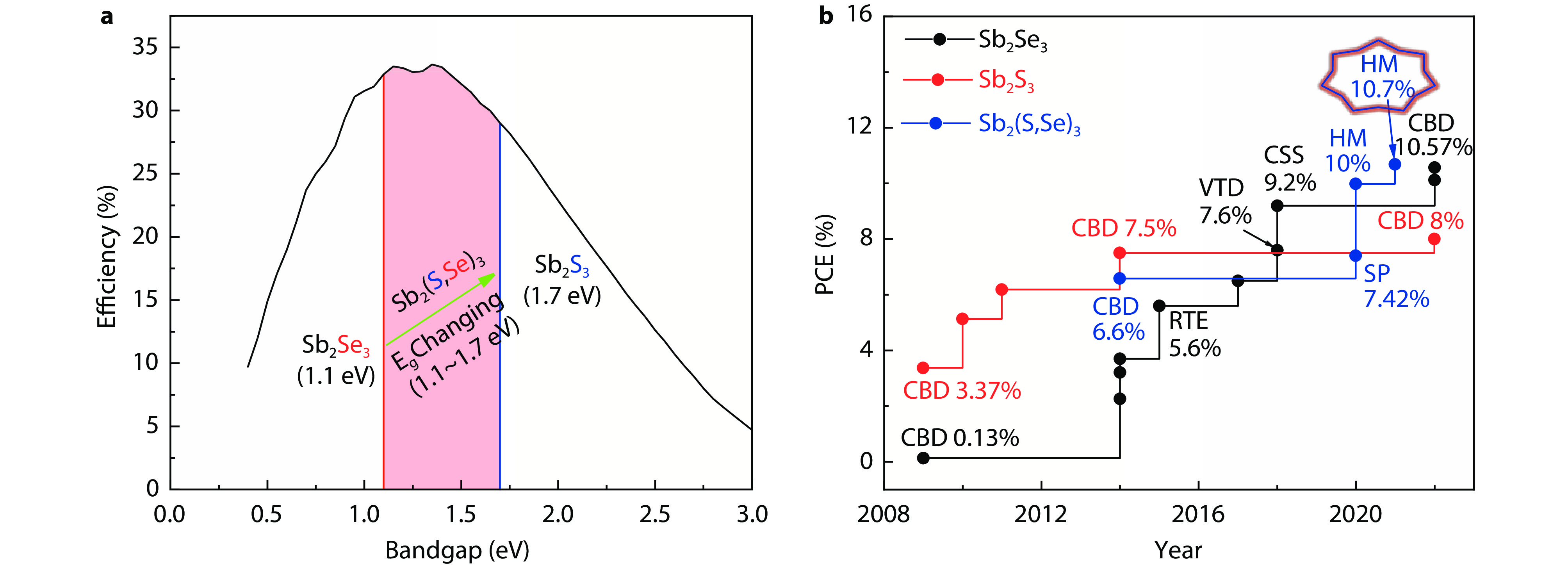
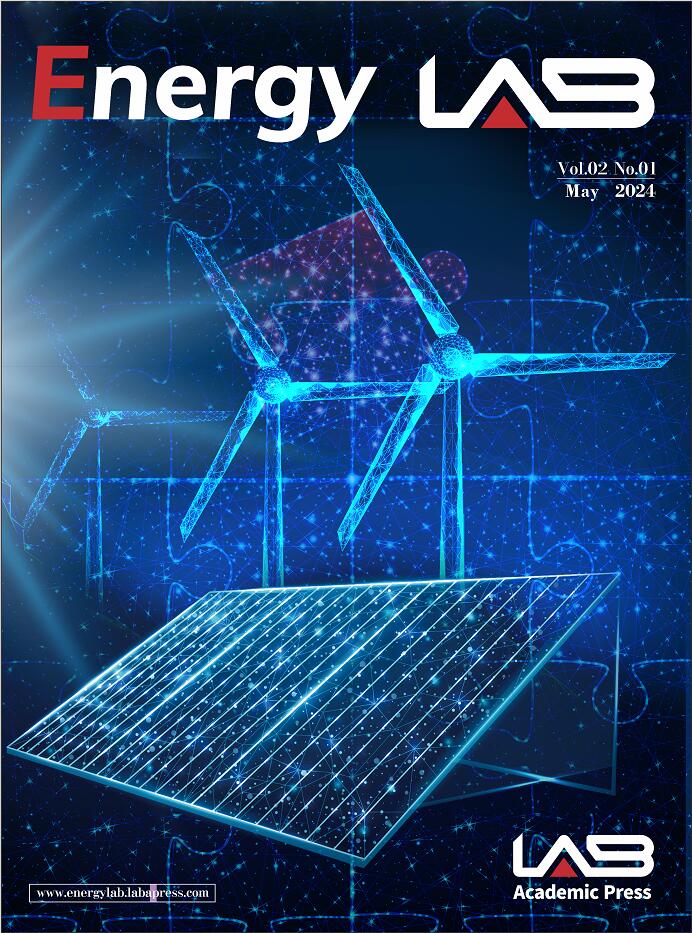
 DownLoad:
DownLoad:
